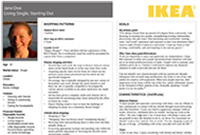Usability Research and Analysis
Key elements to the success of any product or service include knowing your users, their needs, and the environment in which they work; understanding your market space; and validating usability.
User Profile/Persona

User Research Findings Report Example

Usability Testing
Usability testing is one of our key offerings. We recommend conducting user testing throughout the lifecycle of a project, not only to validate usability after development but also at the beginning of the project so as to establish a benchmark against which usability gains might be measured.
We can handle as many or as few aspects of testing as you wish: Analyzing
client objectives; identifying and recruiting target
users; identifying
appropriate usage scenarios; preparing testable prototypes if necessary;
developing tests that relate directly to the basic components of
user-interface design; and delivering recommendations that include
specific ways to improve user-interface design to increase usability
and overall
product satisfaction. At Advancing Ideas, we understand the constraints
of time and budget. Accordingly, we provide both short- and long-term
recommendations, guaranteed to improve your product or service
regardless of how much re-development
can be immediately undertaken. Test results are both quantitative
and qualitative and include both objective metrics—users’ success
rate at accomplishing key tasks—and
also subjective responses to design-related questions.
We utilize a variety of testing techniques, including:
- Traditional: Script-based user testing.
- User-led usability tests: Instead of following a pre-set script of actions, users determine what tasks they will undertake, providing both usability analysis and also information about the ways users value and naturally approach your product or service.
- Rapid prototyping: This approach combines user feedback with agile programming in iterative cycles to quickly assess and test user-interface changes. In early phases of a project, rapid prototypes are used to clarify user requirements or options. An initial prototype is developed and then changed rapidly and frequently as user input is gathered. The input is reviewed, requirements refined, changes implemented and then retested immediately. The results determine the degree to which improvements were made.
Heuristic/Expert Usability Evaluation
Professional usability evaluations identifiy and explain problems with the interface and provide actionable recommendations for improving design. Advancing Ideas’ expert associates will assess your product or service according to current usability standards and tenets. We will also examine your interface according to recognized industry measurement principles (“heuristics”).
Our Expert/Heuristic Evaluations:
- Categorize usability issues according to their estimated impact on user performance or acceptance
- Present a report of identified, categorized, and prioritized usability problems that exist in current designs
- Present specific suggestions for future improvement, where applicable as both short- and long-term recommendations
- Call attention to possible cross-cultural communication issues for globalized/localized designs
User Research
Understanding the needs of your users is a critical first step to creating a successful product or service. Advancing Ideas helps your business understand your potential users’ habits, natural environments, as well as their overall motivations and goals, by gathering user input in the context in which users will actually use your product or service.
We use the methodologies of Ethnographic Research and Contextual Inquiry to conduct user research. We visit potential users in the contexts in which they will use your product—in their offices, home, cars, social gatherings, etc—to observe directly their needs, their goals, and the niches in their lives that your product or service might fill. These methods provide a collaborative partnership between interviewer and interviewee, a venue for open exploration of optimal features and characteristics. Via observation, inquiry, and mutual brainstorming, these User Research methods provide invaluable insight into what users really want from your product or service.
Market Research
To assure success for your product or service, it’s important to understand your market environment. Through research and interviews, we gather key information about the needs of your current and potential customers to help you determine your most likely audiences and customize your product or service accordingly. By analyzing current trends and gaps in your target market, we also provide input on how to position your product or service in today ’s highly competitive market.
Interviews and Focus Groups
These methods of exploring user reactions to your product or service can be extremely useful either at the early stages of a development lifecycle—to determine user needs and help create requirements—or at the final stages of the lifecycle—to gauge overall satisfaction with your product and service and help focus marketing and direct future enhancements.
Unlike less personal methods of interacting with users, such as questionnaires and surveys, one-on-one interviews and focus groups provide means of directly soliciting feedback from your users, prompting an exchange of opinion and information. Through conversation, the facilitator can dig deeply into user issues, preferences, or perceptions that provide invaluable guidance for the development of your product or service.
